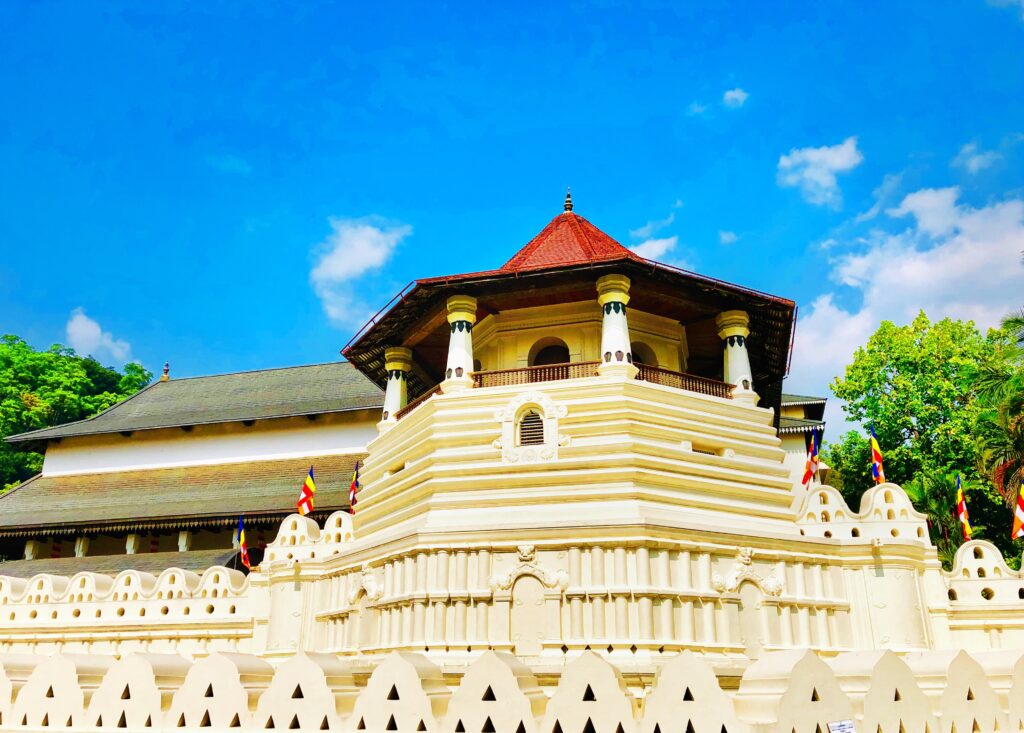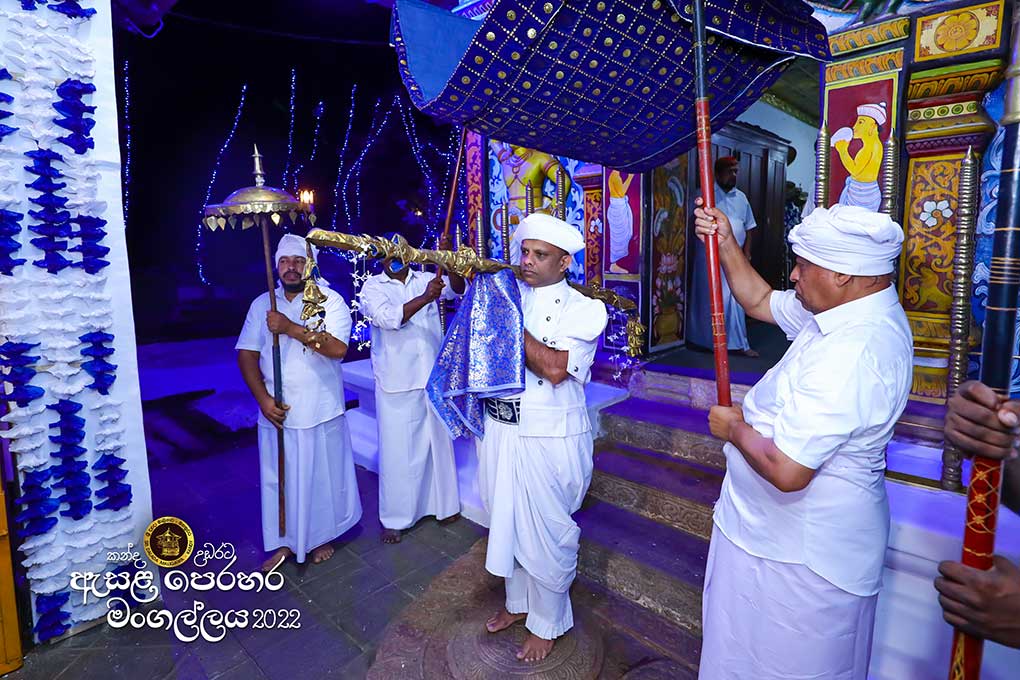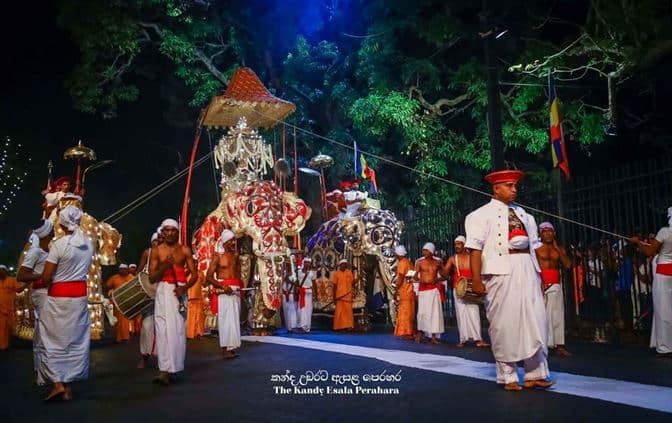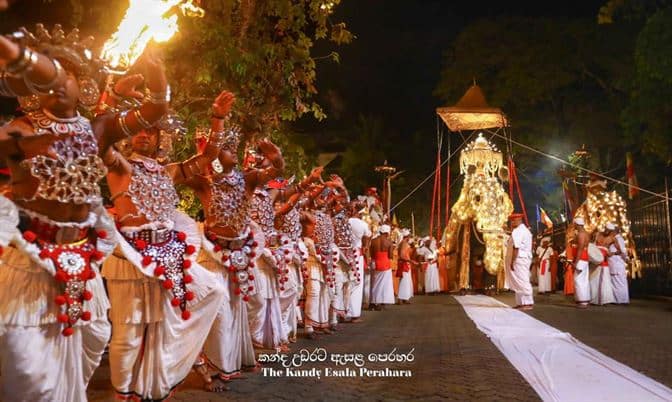- The glorious cultural and religious pageant in Sri Lanka, The Kandy Esala Perahera
- The origin of Kandy Esala Perahera
- Sacred tooth relic in Sri Lanka.
- The establishment of palace of tooth relic in Kandy
- Sacred Tooth
- The Perahera and its different event events
- Taking permission for the Perahera
- Firing squad of Perahera
- Water-Cutting Ceremony
- The items in the Perahera
- Perahera Sandeshaya
- Organization of the Perahera
The glorious cultural and religious pageant in Sri Lanka, The Kandy Esala Perahera
Sri Lanka gives its priority to the tradition and culture in everything they celebrate. The best traditional and historical event in Sri Lanka’s history is the most prestigious Kandy Esala Perahera which continuously held in every year in the months of July/August. The Kandy Perahera or the Esala Perahera is one of Sri Lanka’s foremost religious celebrations and it has been recorded that the Perahera was held each year since the arrival of Buddha’s tooth relic to Sri Lanka. The Kandy Perahera is an elegant procession or parade that flaunts the various talents of the Kandyan people.
Sri Lankan history dates back to 2500 years in pride and every Sri Lankan are fond of their story of pride. Esala perahera witnesses to a prestigious story and let it begin as follows. The most exciting experiences are watching the performance of Sri Lankan drummers and the elephant march. Drumming in Sri Lanka is a unique tradition that dates back to thousands of years.

The origin of Kandy Esala Perahera
The story of the origin of this event is first said by a British sailor of mid-17th century as he was imprisoned in Kandyan kingdom for about 19 years. The reason to held Esala Perahera according Robert Knox was the respect the Sri Lankans have towards the god. “Gods “here represent the Hindu gods worshipped by Sri Lankans.
It is said that perahera was first held in 3rd century BC during the reign of Dutch is coastal area. The Kandyan kingdom then was independent and people did Perahera for the God of rain and later to request the blessings for the King and for the entire country. This was called ‘The ancient Perahera’.
Story of Perahera in present gives a different story.
Sacred tooth relic in Sri Lanka.
After about eight centuries after the passing away of Lord Buddha, the tooth relic was in India and it was brought to Sri Lanka during 4th century BC. It happened due to some internal battles in India to conquer the tooth relic. For the protection of tooth relic and the entire Buddhism, Tooth relic was first brought to Anuradhapura and a palace was built to keep the relic safely. It is said that it was King Kithsirimewan ruled the country during this time.

According to the historical facts, King Meghawanna was the first King to build a Temple of tooth relic and to establish a Perahera tradition. The ancient Mahawamsa book depicts that the Perahera was a glorious event from ancient times but with some invasions and battles, the tooth relic was transferred to different kingdoms for the protection.
The establishment of palace of tooth relic in Kandy
After King Wimaladharmasuriya ɪ enthroned the Kandyan kingdom in 1592, the sacred tooth relic was taken into his duty and responsibility. This is the base for the current temple of tooth relic and the Kandy Esala Perahera.
The utmost difference between ancient and new Perahera is the ‘Sacred tooth relic’. The ancient Perahera was mainly based on Hindu beliefs due to the effect of Hinduism in Sri Lanka which was a result of Indian queens’ marriages with Sri Lankan Kings. During the reign of King Keerthi Sri Rajasinghe, the sacred tooth relic was considered a private property, but with the effort of Upali Thero, the king advised to make the sacred tooth relic public to be worshipped at Perahera.
During the British rule in Kandyan Kingdom, the duty of tooth relic was given to Buddhist monks and ‘The Diyawadana Nilame’ was appointed for the management and responsibilities of tooth relic. Though the Perahera was abolished during British rule, it was re- established in 1823.
Sacred Tooth
The sacred tooth is supposed to have been brought to Ceylon in 311, concealed in the hair of an Indian princess, Hemamala and kept in a temple at Anuradhapura. It was Esala Perahera immediately recognized as the island’s most precious possession, and the King of Lanka considered it the supreme symbol of his authority. It was stolen once or twice, but always recovered and put back in its shrine. Then in 1560 it was captured by the Portuguese and carried away in triumph to their stronghold of Goa on the western coast of India.
The tooth that belonged to Buddha was reportedly ground into powder, burned, and thrown into the sea by the Archbishop of Goa, a devoted Catholic who considered it a heathen idol. But many believe that it was only a copy of the tooth that was destroyed, and that the real tooth is still enshrined in the temple at Kandy. Those privileged enough to have seen the relic describe it as being nearly three inches high and about as thick as a man’s little finger; if so, it could not have come from any human mouth. It is possible that the monks of Kandy found another tooth to replace the one they had lost.
The sacred tooth is housed in seven nesting caskets, carried on the back of Raja the tusker. The Sri Lankan Buddhists consider this tusker in godliness.
The Perahera and its different event events
This glorious and most picturesque Perahera consist of diferent hereditary dance troops and musical bands. It is apparently the identity of Sri Lankan culture and tradition. Thousands of visitors worldwide are yearning to watch this beautiful pageant and during the Perahera season, Kandy is none other than the heaven. The present stage of Esala Perahera was originated in the reign of King Keerthi Sri Rajasinghe.
It is believed that Kandy Esala Perahera has been started in Kandy in middle half of the 18th century BC. Earlier there was only four devol Peraheras (Natha, Vishnu, Katharagama, Paththini) but with the initiative of Welivita Sri Saranankara Thero, the priority was given to the Buddhism in Perahera.
Planting ‘ Kap’

This is the very first even in Perahera and it signifies the commencement of Esala Perahera. The priests from four devols find a holy jak tree in Aluth nuwara devol. The milky liquid of the tree symbolizes the prosperity of the naton. This is done in an auspicious time and they cut the tree for four pieces to represent four devols and they plant them in four devols. This is a ritual coming from early times to sign the commencement of the Esala Perahera.
Devol Perahera
The four pieces cut from the holy jak tree are devided among four devols. This is called ‘Kapa’ and each devol take this Kapa to the devol by a perahera. The priests take it to their devols amidst the golden ornaments which belong to devols, flags and drummers. This is a kind of mini Perahera but those drummers, tuskers are not dressed in fancy as in main Esala Perahera. Even there is not the participation in craftsmen or pilgrims in this. There have five peraheras like this before the final Perahera event.
Kumbal Perahera
Kumbal Perahera is held on the 5th day after four devol Peraheras. This Kumbal Perahera also held during five days as five mini Peraheras. The priests and ‘Basnayake Nilame’ from four devols carry golden ornaments in another perahera to the Temple of tooth relic and Kumbal perahera carries the sacred tooth relic along with golden ornaments. The Diyawadana Nilame is the main position here in Kumbal Perahera but he is not dressed in his fancy attire in this. The members of the Perahera and other music and dancing troops are included to this Perahera.
On the sixth night, the Kumbal Perahera begins and continues on for five days. Initially, the Devale Peraheras assemble in front of the Temple of the Tooth, which is Sri Lanka’s most important Buddhist Shrine and where the Buddha’s Sacred Tooth Relic has been kept since the 16th Century, with their insignias placed on the ransivige (a dome-like structure) accompanied by the Basnayake Nilames (the lay custodians of the Devales).

Randolee Perahera
After five consecutive days of Kumbal Perahera, The most beautiful Randolee Perahera takes place again for five days. This is the most glorious and colourful event in Esala Perahera. It was given the name of a queen, ‘Randolee’ who was a queen of a Kandyan King. It is said that this queen has participated in Peraherera. This Randolee perahera is larger and more colourful than the earlier events. This includes Hevisi troops, other traditional musical bands, dancers, flag bearers and a considerable number of elephants and tuskers.
The final Randolee Perahera
This event is something else in tourism and Kandy city become a crowded heaven on this day. Almost every Sri Lankan has watched this beautiful Perahera in their lifetime. The elephants and tuskers are dressed in beautiful costumes, the Nilames and hundreds of dancers and drummers and Perahera members make this day the most glorious and picturesque. On this day, at the auspicious time the Perahera starts. The Diyawadana Nilame in full traditional Kandyan dress will enter the inner chamber to receive the Perahera Karanduwa containing the Buddha Relics.
Taking permission for the Perahera
The Perahera begins after granting permission from Diyawadana Nilame, the head of the palace. For this purpose, all the members of Perahera crew including Basnayake Nilame dress in their duty attire and get together to meet Diyawadana Nilame. This happens in his office. On this day, the Perahera crew obtains permission and blessings from Diyawadana Nilame.
Firing squad of Perahera
There are 3 major cannonballs heard before Perahera. With the first shot, the four devol Peraheras join the main Perahera. Then the second shot is heard when the Diyawadana Nilame places the Sacred tooth relic in golden homage on the tusker. The third shot is heard when the tusker joins the Perahera with tooth relic on him. This signifies the commencement of the Perahera and it starts to move.
Water-Cutting Ceremony
On the tenth and final day of the festival, the Esala Perahera procession is held in the daytime. It ends up on the banks of the Mahawali River just outside the city of Kandy. The tooth is carried down to the river and lowered into a special shelter or decorated boat. There, the priests of the four Hindu temples draw their swords and strike the water. Then they fill four clay bowls with the water and take them back to their temples, where they are kept until the following year’s celebration. Sacred dances are then performed to ward off evil spirits and to seek the blessings of the gods.
The items in the Perahera
- The whip crackers
- Buddhist flag bearers
- Provincial flag bearers
- Sword holders
- Fireball works
- Peramune Rala
- Panikkiyan
- Gajanayake Nilame
- The first drummers
- Tuskers
- Dancers (Pol Mal)
- Horanee players
- Drummers (Thammettam, Dawul)
- Different traditional local dances
- Korala
- Nagasignhem music
- The casket bearer tusker
- Tuskers of sides
- Kavikara Maduwa
- The Diyawadana Nilame
- Four devol Peraheras

The crowd is impatiently waiting to get a glimpse of the tusker carrying the relic’s casket. It’s a wonderful sight to see the tusker dressed in a decorated costume and brilliantly illuminated bearing the ransivige (golden casket) in which the Perahera Karandawa rests on a velvet cushion, with garlands of jasmine flowers hanging dangling above it and strings of lights flickering all the time, tread over the pavada in assured steps under the canopy held over the ransivie by 16 able bodied men with poles and strings. As the karanduwa passes by, the crowd, stand up and with their hands clasped together chanting sadhu, sadhu, sadhu thereby paying their homage to the Sacred Tooth Relic.
Perahera moves in Dalada weediya, Yatinuwara weediya, Kotugodelle weediya, Kande weediya, D.S.Senanayake weediya and finally ends up in Dalada Maligawa and this signifies the end of the Perahera. This Perahera ending up in Palace is called ‘Perahera Gevadeema’.
Perahera Sandeshaya
After the day of the Esala Perahera, it is customary for the Diyawadana Nilame and the Basnayake Nilames of the four devalas to report to His Excellency the President that the Esala Perahera was satisfactorily conducted. On completion of the Perahera, the Diyawadana Nilame would lead a procession consisting of the Nilames of Sathara Maha Devalas and the Nilames of rural devalas to the President’s Pavilion carrying a sannasa (formal letter) known as the Perahera Sandeshaya to the President stating the successful completion of the annual Esala Perahera. The President would meet and receive the sannasa at the entrance to the President’s Pavilion.
Organization of the Perahera
The rituals and responsibilities connected with the Tooth Relic are conducted by Monks of the Malwatte Chapter and Asgiriya Chapters of the Buddhist clergy in Sri Lanka. It is the duty of the Diyawadan Nilame to organize the Perahera and thus he summons a large number of officials of the Temple of the Tooth and entrusts them with various ceremonial duties connected with the conducting of the Perahera. He first gets the auspicious time from the Nekath Mohottala, the advisor on astrological matters. The task of organising the different types of drummers is handed over to the four officials known as the Panikka Mura Baarakaruwo.
The Maligawa officials also meet the owners of the elephants due to take part in the Perahera (most elephants are privately owned). The dance troupes are given time to prepare. The Basnayake Nilames (the lay custodians of the Devales) are then told to organize their processions.
As the Esala Perahera draws to an end, the onlooker is apt to conclude that it is nothing but sheer ingenuity of the Buddhists from ancient times to have organized the country’s talents in arts and crafts including drumming and dancing into a cultural pageant of such magnitude and offer it to the Sacred Tooth Relic of Lord Buddha as a form of veneration. All the talents of Perahera members are appreciated later on.



